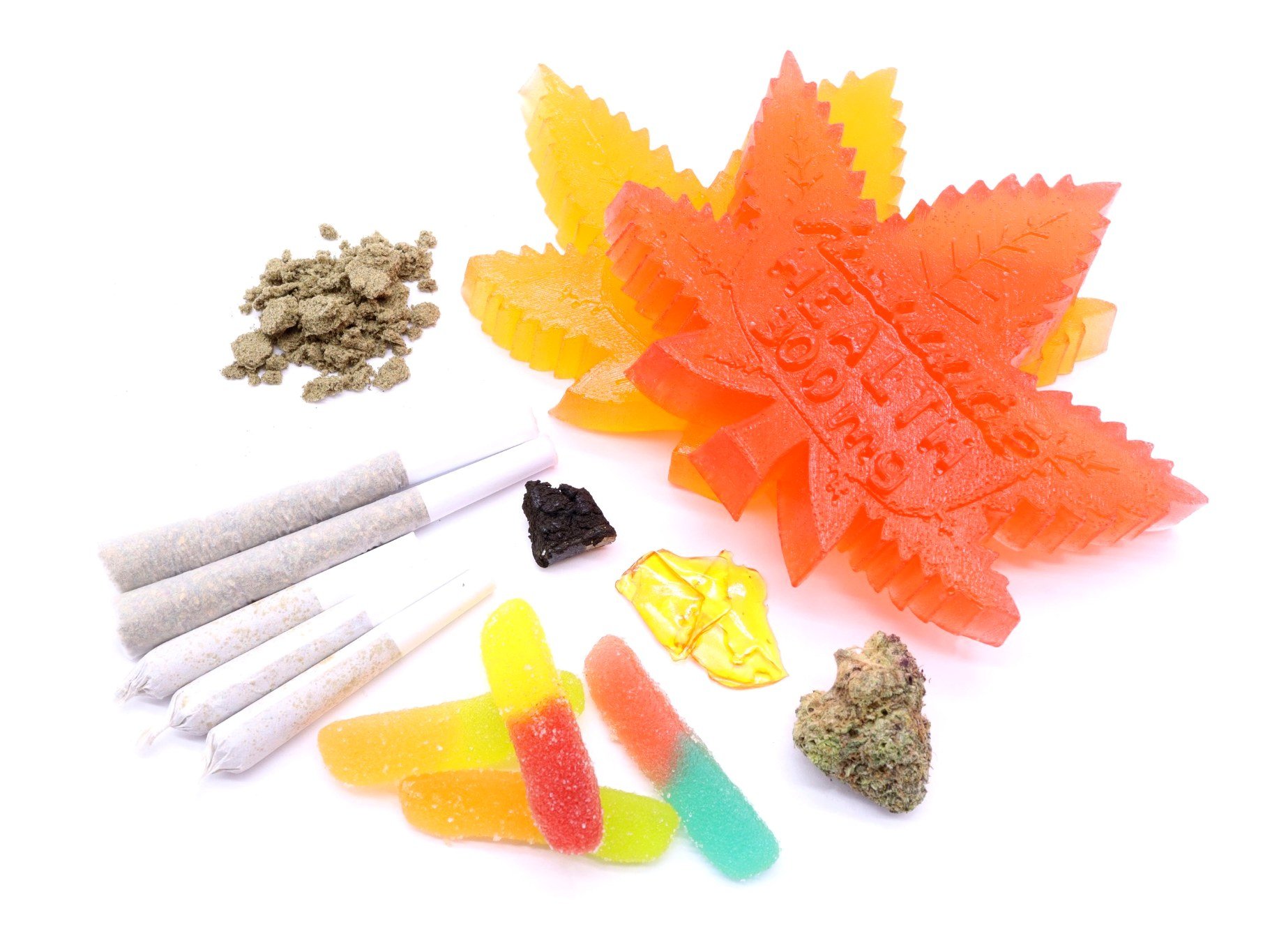Picture this: You’ve purchased a high-potency cannabis product – maybe some edibles, a concentrate or some top-shelf AAAA+ buds. You’re excited to open the container up and melt into the couch after a very long week of work. You get home, you get settled with your snacks for the eventual munchies, and you down your cannabis. Now… the wait for it to kick in begins…
But wait, it’s already been a couple hours! Why don’t you feel anything yet?! Frantically, you down a few more bites/drops/nugs, but after even more time you’re still not feeling it. Frustrated, you pick up the container to check the label – which, annoyingly, you’re still able to read just fine. Then it hits you (not the weed, the ‘doh’ moment of realization)… You bought the wrong, low-dose stuff!
It happens to the best of us: THC edible labels being mistaken for CBD values, mistaking total cannabinoids contents for active THC, or misunderstanding what percentage of THC gets you high. Learning how to read cannabis labels correctly takes practice, even to the most experienced stoner’s bloodshot eyes.
What do the labels on cannabis mean? What are total active cannabinoids? How about total cannabinoids in general? Let’s answer some of the most commonly pondered questions about cannabis labeling so that you don’t fall victim to some of these easy-to-make mistakes.
WHAT DO THE LABELS ON CANNABIS MEAN?
First off, we need to set a few definitions for anyone who is coming into cannabis completely green. Cannabinoids, terpenes, total cannabinoids, active compounds, and more convoluted terms are bandied about so frequently and yet many Canadians don’t really know what they mean. Let’s cover the basics:
CANNABINOIDS
Cannabinoids are the active compounds that cause the biochemical reactions within our brains and bodies whenever we inhale, ingest or absorb cannabis/hemp products. There are hundreds of known cannabinoids, but to date we know very little about most of them. THC, CBD, CBG, CBN, THCV and a handful of others have been heavily researched thus far and make up the majority of our understanding of cannabinoids. That being said, we still have so much to learn about these wonderful, mysterious phyto compounds.
Another important consideration with regards to reading cannabis labels has to do with how cannabinoids influence one another. In most cases, THC will cause mind-altering effects like hallucinations, giddiness, relaxation and delayed responses/reactions. CBD, on the other hand, can relax you or fight pain like THC can but without the heady, brain-buzz. Cannabidiol also goes one step further in counteracting some of the effects of Tetrahydrocannabinol.
This means that anytime you ingest cannabis products with both THC and CBD contents, the CBD might be reducing the psychoactive effects of the THC, depending on the ratios of either compound. For example, a popular full-spectrum cannabis product will contain 2:1 CBD to THC. This means that there’s twice as much CBD and THC, so the chances of CBD minimizing the psychoactive properties of the THC are much greater.
There’s no “X:X” formula for how much CBD will minimize THC’s mind altering effects, so you need to play around with different values and doses. Everybody’s cannabinoids tolerances are different, so dosing cannabis will always require careful attention, patience and consistency.
TERPENES
Terpenes are a lot more obvious, in your face and easier to detect than phytocannabinoids because they are the aromatic and flavorful compounds found within cannabis varieties. As we discover more about them in their over 150 variations, we’re discovering that terpenes not only shape how cannabis will taste/smell but also impact its potencies. Think of terpenes as being able to enhance a particular cannabis strain’s cannabinoids and how those compounds affect our minds & bodies.
THC
Tetrahydrocannabinol, otherwise known as THC, is one of the most well-known active compounds we associate with cannabis and hemp. THC is so renowned and infamous due to its role in initiating psychoactivity in our brains and bodies. What is psychoactivity? Basically, the “high” effects you experience from inhaling or ingesting cannabis can be largely attributed to its THC contents.
Other cannabinoids and terpenes (active compounds) impact this as well, but from our current understanding THC is the driving force behind the mind-altering effects of cannabis. THC values can vary greatly between cannabis cultivars, so genetics and cultivation can certainly alter the THC levels in a given crop.
CBD
On the other side of THC, Cannabidiol (CBD) is another thoroughly researched cannabinoid that is prevalent in cannabis and hemp. Unlike Tetrahydrocannabinol, CBD is non-psychoactive – meaning, it does not get you “high” or alter your perceptions of reality, induce hallucinations or immobilize you like THC is known to do. Cannabidiol is more closely associated with hemp cultivars because of their high-CBD, low-THC contents across multiple genetics.
DECARBOXYLATION
An important chemical process by which raw, acidic forms of cannabinoids like THCA or CBDA are put under heat and pressure, and become activated. Once “activated” by being broken down into more absorbable forms (i.e. THC, CBD), cannabinoids can induce the mental and physical effects we associate with cannabis use. In this way, without combustion or some other heat source, many cannabinoids are simply ‘dormant compounds’ that do not get you high or have as much medical potency as we’d assume.
Many of these terms are included on cannabis packaging, but something to keep in mind is that cannabis labels very rarely include any information beyond THC or CBD values. Other cannabinoids or terpenes aren’t listed because: a) it’s not a legal requirement to do so, only THC and CBD are regulated (so far); and b) not as much is known about cannabinoids & terpenes because cannabis is newly legalized or deregulated in most parts of the world.
So, some of the details you can expect to see on most cannabis labels:
Total THC/CBD
Active THC/CBD
Total THCA, THCV (in relation to actual, active THC contents)
Total CBDA (as it relates to active CBD levels)
You might also come across many kinds of dosage listings, such as “per mg” or “%”. Let’s review the different ways in which total cannabinoids are listed versus total THC or total CBD values.
TOTAL CANNABINOIDS VS TOTAL THC
Learning what cannabis labels mean is primarily an exercise in weighing your options. For the sake of comparison, imagine your standard beer bottle and the kinds of information listed on its label: alcohol in %, volume in ml/L, ingredients and where it was manufactured. This is the standard for most alcoholic beverages, no matter what kind of spirits you’re after.
When it comes to cannabis, imagine that same beer bottle but it has to list the active alcoholic levels in %, but also the potential for more alcohol being created during storage or mid-consumption. Then add factors like what specific strains of hops were used to brew this beer, on top of what kinds of flavors and aromas resident in the hops might affect how the alcohol interacts with you once consumed. Did you get all that?…
Figuring out what are the active cannabinoids, what total cannabinoids might be present, or what percentage of the THC will get you high in relation to the other cannabinoids present can make for a very confusing read every time you pick up a bottle of cannabis oil or peer at a THC edible label.
So, how can you distinguish between ‘Total Cannabinoids’ and ‘Total THC’ or ‘Total CBD’? Fresh cannabis actually has very little THC contents because most of it is in the raw, acidic form of THCA. During drying & curing, THCA can be converted into THC, albeit in very miniscule quantities. In order to activate large amounts of THCA into the THC many of us are after, you have to smoke it, vape it, cook it or apply heat or pressure for enough time to decarboxylate your buds.
This hints at the reasoning behind listing both Total Cannabinoids and Total THC. If only the activated THC levels were listed in the raw cannabis buds, then the THC values would be very low and seem unappealing to most consumers. Total cannabinoids show the potential THC or CBD contents that can be achieved through smoking, vaping or cooking said nugs. So, it’s kind of like “actual vs potential” effects listed on cannabis levels.
When you see a low figure like 1.50% THC on a package don’t assume this means the buds have no THC in them – the corresponding 15 mg/g Total THC value hints at the actual amount of Tetrahydrocannabinol you can expect when toking on this particular strain. The same kinds of calculations are true for CBD, although with Cannabidiol you might not be as concerned because of its lack of psychoactive properties.
THC edible labels might show both the same value (total cannabinoids + total active THC), however they’ll likely look backwards – much higher active THC values and less total cannabinoids amounts because they’ve been decarboxylated (i.e. cooked, baked, prepared). With these complications out of the way, let’s figure out what percentages of the THC gets you high or what levels of the active compounds you need to feel the effects you’re after.
HOW TO READ CANNABIS LABELS
Due to cannabis legalization in Canada and now Mexico, the standard for displaying dosage/potency for most cannabis products is shifting from percentages to milligrams per gram. To avoid causing too many issues with past vs present customers, cannabis companies have taken to listing cannabinoids in both % and mg/g.
Regardless what values are listed, it is quite easy to convert percentages into milligrams, and vice versa. In order to understand what percentages of THC get you high, or to track your dosing by understanding what the total cannabinoids are per container you’ll need to do a little math. Don’t fret, you don’t have to hold a major in calculus for any of these easy conversion methods: Divide or Decimal.
Divide
The first and most common method for converting milligrams per grams into percentages of total cannabinoids simply involves dividing the mg potency by a factor of 10. For example:
Total THC 420 mg/g…
Therefore, 420 / 10 = 42…
So, Total THC = 42%
Decimal
The decimal method is just as easy and involves less math, more like accounting work. In this instance, we’re simply moving the decimal point over by one. For example:
Total THC 420 mg/g…
From 420.0 we will move the decimal to the left by one…
Therefore, Total THC = 42.0%
There you have it – the fundamentals of how to read cannabis labels. It’s not so tough to understand what cannabis labels mean when you break down the values. There are a bunch of health warnings and disclaimers on cannabis labels as well, but we won’t go into those (for obvious reasons, most of us reading this article will disagree vehemently with the government’s opinions of cannabis’ “health risks”).
Now that you can understand cannabis labels, we hope you will avoid any future mix ups of THC and CBD. Make sure you pass on this essential knowledge to help your fellow stoners how to read cannabis labels. If cannabis is health and knowledge is power, then we’ve all got a healthy dose of wellbeing with cannabis on our side.


